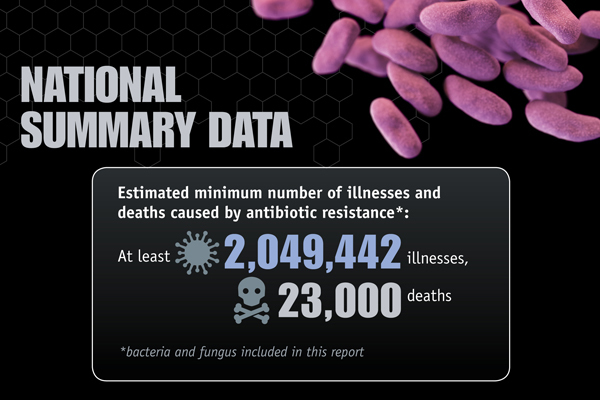 CDC estimates that there are over 2 million illnesses and
23,000 deaths annually in the U.S. that are related to antibiotic-resistant
bacteria. Many of these illnesses and deaths occur among residents of nursing
homes who are especially vulnerable to infections. CDC reports that 70 percent
of nursing home residents are treated with antibiotics each year. Often the
antibiotics are not needed, but as a result of taking them the resident goes on
to develop a C. difficile infection or other
infection due to antibiotic-resistant bacteria. The National
Strategy to Combat Antibiotic-Resistant Bacteria
(https://www.cdc.gov/drugresistance/federal-engagement-in-ar/national-strategy/index.html)
was created to slow the development and spread of resistant infections. By
November 28, 2017, the Centers for Medicare and Medicaid (CMS) will require
long-term care facilities to establish antibiotic stewardship programs that
include antibiotic use protocols and systems to monitor antibiotic use. This
month’s HAI Update features helpful resources for establishing a stewardship
program and preventing resistant infections.
Registration quickly filled for the 2017 MN Antibiotic
Stewardship Conference being held today, March 15, but don’t despair if you
were unable to register! We are exploring the possibility of creating more
opportunities in the coming months. Stay tuned for more information.
Do you want to establish a stewardship program at your
facility but don't know where to start? Check out the Minnesota
Antimicrobial Stewardship Program (ASP) Toolkit for Long-Term Care Facilities (http://www.health.state.mn.us/divs/idepc/dtopics/antibioticresistance/asp/ltc/index.html).
The first three appendices are especially helpful for building an ASP: Appendix A
provides the conceptual model for an ASP; Appendix B outlines steps and
strategies for implementing an ASP with links to related guidelines; and
Appendix C provides a gap analysis tool so that you can assess what is already
in place in your facility and develop a work plan for establishing missing
elements.
If you work in a nursing home or skilled nursing facility in
Hennepin, McLeod, Olmsted, Ramsey, or Rice Counties, you may be contacted by
MDH in the next couple of months and invited to participate in a project
sponsored by CDC. The project will assess infections and use of antibiotics in
long-term care settings. The aim of the project is to better understand how
infections are identified, diagnosed, and treated with antibiotics in order to
identify practice improvements, focus infection prevention efforts, and
decrease inappropriate antibiotic use. MDH will randomly select 20 long-term
care facilities from those five counties to be invited to participate in the
point prevalence survey. If invited by MDH, we hope you will consider
participating in this important project!
Clostridium difficile
infection (CDI or C. difficile), sometimes referred to as the deadly diarrhea, affects more
than 100,000 U.S. nursing home residents each year. Antibiotics have been
identified as a major risk factor for developing C.
difficile infection. To combat C. difficile, the
Minnesota Department of Health (MDH) and Lake Superior Quality Innovation
Network (QIN) invited nursing homes throughout the state to participate in the
Nursing Home C. difficile Initiative that
started in 2016. This initiative is a part of a nationwide partnership between
state and federal public health agencies, health care facilities, providers, and
infection control personnel, with all partners sharing the common goals of
measuring our progress in eliminating this pathogen and promoting safer health
care environments.
Participating nursing homes track C. difficile infections in CDC's
National Healthcare Safety Network (NHSN), the nation’s largest HAI tracking
system. As of November 2016, almost 50 MN nursing homes have enrolled in NHSN
and have started to submit data monthly. By tracking infections, these
facilities can identify problems and track progress toward eliminating
infections. CDC will use reported data to develop national benchmarks.
Facilities will be able to compare their rates with similar nursing homes using
these benchmarks.
Nursing homes that are enrolled in NHSN are also able to
track other HAIs such as catheter-associated urinary tract infections (CAUTIs)
and multidrug-resistant organisms (MDROs). In the near future, they will also be
able to track antibiotic use through NHSN.
If you are interested in enrolling your nursing home in NHSN
and tracking HAIs but you're not sure how to get started, call 651-201-5414 and
ask for someone from the Healthcare-Associated Infections Unit.
 |
|
Join
the One & Only Campaign to help raise awareness about safe injection
practices! The Campaign aims to end infections from unsafe injection practices and empowers patients and providers to demand the use of one needle, one
syringe, only one time for every injection. Members have access to campaign
materials, email updates, and will receive recognition on the One & Only
Campaign website. Professional organizations, nonprofit organizations, health
care systems, provider groups, and private companies are all welcome to join the effort.
Learn more at the One
& Only Campaign Membership (http://www.oneandonlycampaign.org/campaign-members)
page. |
Share healthcare-associated infections, antibiotic
stewardship, and other health information with people in your community by
connecting with MDH on:
• Facebook
(www.facebook.com/mnhealth)
• Twitter
(www.twitter.com/mnhealth)
• Instagram
(www.instagram.com/mnhealth/)
• LinkedIn
(www.linkedin.com/company/mnhealth)
• YouTube
(www.youtube.com/user/MNDeptofHealth)
|